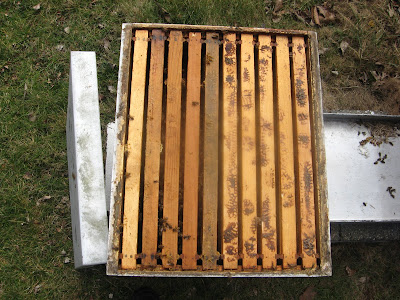The picture below is looking down into the lower hive body of the weak colony which now is not so weak.

Here is a picture of the queen. She has fattened up once again and is laying eggs. She is laying eggs in the empty cells between the capped brood. This was one of the frames that were donated to the colony. Almost every empty cell represents a new bee which has emerged and joined the colony in the past week. I suppose that since the bees cluster on the capped brood to keep it warm that this was the most reasonable place for her to lay the eggs to keep them warm. If you click on the picture you can see the eggs in the cells, they are left of her. It looks like she just made it over this side of the frame as there were eggs on the other side and another frame.

I must say that I feel much better now than I would have when I discovered this colony had died out. If you can take about fifteen or twenty minutes to devote to a weak colony you can save it. I don't know how much money you make but I'd rather spend about fifteen minutes to save a colony than up to one hundred dollars or more to replace it because I let it die out. It's so easy to do a first year beekeeper could do it if the read the first post, Strengthening a Weak Colony."
I took some pictures but they were not very good. Hopefully these two pictures here will suffice for now. I'll be sure to keep you updated on this weak colony as it gains in strength and population.

1 comment:
I'm enjoying your blog immensely ! I am a beekeeper in Ohio and I plan to visit my hives tomorrow for the first time since the cold spells. I have my sugar syrup all ready to take to them and I'm nervous about what I'll find. I've never fed inside the hive, but I'm going to this year by inverting jars on the frames and incasing them in a hive body. I have 5 hives - had six last year but lost two and split a strong one. I need to replace all the queens because I didn't last year. Would you automatically replace a queen if you witnessed evidence of a good layer for the third year in a row ?
Post a Comment